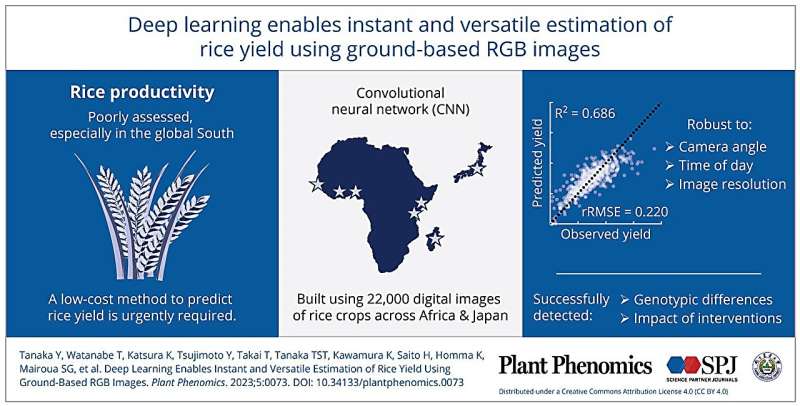This article has been reviewed according to Science X's editorial process and policies. Editors have highlighted the following attributes while ensuring the content's credibility:
fact-checked
trusted source
proofread
Artificial intelligence can now estimate rice yields, according to new study

With the rise in global demand for staple crop products projected to substantially increase by 2050 due to population growth, rising per capita income, and the growing use of biofuels, it is necessary to adopt sustainable agricultural intensification practices in existing croplands to meet this demand. However, estimation processes currently employed in the global South remain inadequate. Traditional methods like self-reporting and crop cutting have their limitations, and remote sensing technologies are not fully utilized in this context.
However, recent advancements in artificial intelligence and machine learning, particularly deep learning with convolutional neural networks (CNNs), offer promising solutions here. To explore the scope of this new technology, researchers from Japan conducted a study focusing on rice. They used ground-based digital images taken at harvesting stage of the crop, combined with CNNs, to estimate rice yield. Their study appeared in Plant Phenomics.
"We started by conducting an extensive field campaign. We gathered rice canopy images and rough grain yield data from 20 locations in seven countries in order to create a comprehensive multinational database," says Dr. Yu Tanaka, Associate Professor at the Graduate School of Environmental, Life, Natural Science and Technology, Okayama University, who led the study.
The images were captured using digital cameras which could gather the required data from a distance of 0.8–0.9 meters, vertically downwards from the rice canopy. With Dr. Kazuki Saito of the International Rice Research Institute (formerly Africa Rice Center) and other collaborators, the team successfully created a database of 4,820 yield data of harvesting plots and 22,067 images, encompassing various rice cultivars, production systems, and crop management practices.
Next, a CNN model was developed to estimate the grain yield for each of the collected images. The team used a visual-occlusion method to visualize the additive effect of different regions in the rice canopy images. It involved masking specific parts of the images and observing how the model's yield estimation changed in response to the masked regions.
The insights gained from this method allowed the researchers to understand how the CNN model interpreted various features in the rice canopy images, influencing its accuracy and its ability to distinguish between yield-contributing components and non-contributing elements in the canopy.
The model performed well, explaining around 68%–69% of yield variation in the validation and test datasets. Study results highlighted the importance of panicles—loose-branching clusters of flowers—in yield estimation through occlusion-based visualization. The model could predict yield accurately during the ripening stage, recognizing mature panicles, and also detect cultivar and water management differences in yield in the prediction dataset. Its accuracy, however, decreased as image resolution decreased.
Nevertheless, the model proved robust, showing good accuracy at different shooting angles and times of day. "Overall, the developed CNN model demonstrated promising capabilities in estimating rough grain yield from rice canopy images across diverse environments and cultivars. Another appealing aspect is that it is highly cost effective and does not require labor-intensive crop cuts or complex remote-sensing technologies," says Dr. Tanaka.
The study emphasizes the potential of CNN-based models for monitoring rice productivity at regional scales. However, the model's accuracy may vary under different conditions, and further research should focus on adapting the model to low-yielding and rainy environments. The AI-based method has also been made available to farmers and researchers through a simple smartphone application, thus greatly improving accessibility of the technology and its real-life applications.
The name of this application is 'HOJO', and it is already available on iOS and Android. The researchers hope that their work will lead to better management of rice fields and assist accelerated breeding programs, contributing positively to global food production and sustainability initiatives.
More information: Yu Tanaka et al, Deep Learning Enables Instant and Versatile Estimation of Rice Yield Using Ground-Based RGB Images, Plant Phenomics (2023). DOI: 10.34133/plantphenomics.0073
Provided by Okayama University





















